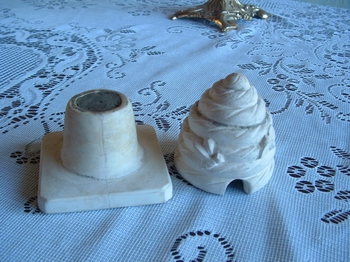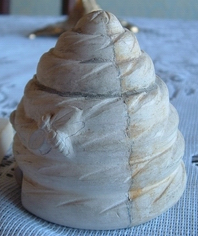|
I’ve told the story of this beehive several places before so won’t retell it here. I’ll focus on the mold itself. As you look at this photo, you can see that the inner part that held the honey has a line on the front side. That represents the seam where two halves of the plaster mold fitted together. The line shows you how the plaster mold was made, in this case an interesting one with a small opening at the top but a comparatively wide hollow base. several places before so won’t retell it here. I’ll focus on the mold itself. As you look at this photo, you can see that the inner part that held the honey has a line on the front side. That represents the seam where two halves of the plaster mold fitted together. The line shows you how the plaster mold was made, in this case an interesting one with a small opening at the top but a comparatively wide hollow base.
In this  image you can see the two halves as well. There is also a black line around the third layer of the skep (originally made out of sheaves of straw) and I am not sure whether or not that meant that dad actually build a three part mold, i.e. one that had a third piece that fitted over the top of the skep. Whatever, you can see at least 2 parts. image you can see the two halves as well. There is also a black line around the third layer of the skep (originally made out of sheaves of straw) and I am not sure whether or not that meant that dad actually build a three part mold, i.e. one that had a third piece that fitted over the top of the skep. Whatever, you can see at least 2 parts.
The way 2 part molds are made is also easy and is best done in a sand box. The item is buried into the sand half way. Think about the left piece in the image above. TO be sure that exactly one half is exposed, dad would use plasticene as a ‘dam(n)’. He would press it against the item until it was tightly in place. He’d take a knife to cut a straight edge, and then press the bottom half and the plasticene dam(n) in the sand, and create another box around the item such that when he poured the plaster of paris into the sand box, it would rest around the top half of the item. Or course, the item was well Tincture of Green-soaped well before the plaster was poured into place. I wish I had an image to show what I am poorly describing. It sounds harder than it really it. When that half of the mold is hardened, the whole ensemble is removed from the sand box.
The plasticene damn that covered the bottom half of the item was removed, and the mold half was gouged with a sharp knife to make a depression. then when the second half of the mold is poured -after it is tincture of green soaped- the plaster naturally fills those depressions. When the whole thing is over, the depression and the bump of plaster that fills it, function together as keys” to ensure that the two halves fight in the proper places in relationship to each other.
Another interesting ponit is raised by this image, the bee. When you think about it, when the halves of molds are pulled apart, they must be pulled straight out, i.e. the pressure must be vertical to the long axis of the item being molded. That means that if the bee wings in this case were undercut, the mold would not come off, or if it did, it would deform or break the ends of the wings. So that means that when one is making a mold, surfaces must taken into account to allow smooth separation of the sections of molds.
In some instances an item to be molded has a shape such that a two part mold cannot be made because there are curves and corners that cannot be accommodated with two parts. In this instance, the mold maker simply examines the item and figues how where to position a thrd, fourth or fifth, etc. mold piece to allow clean pulls.
|